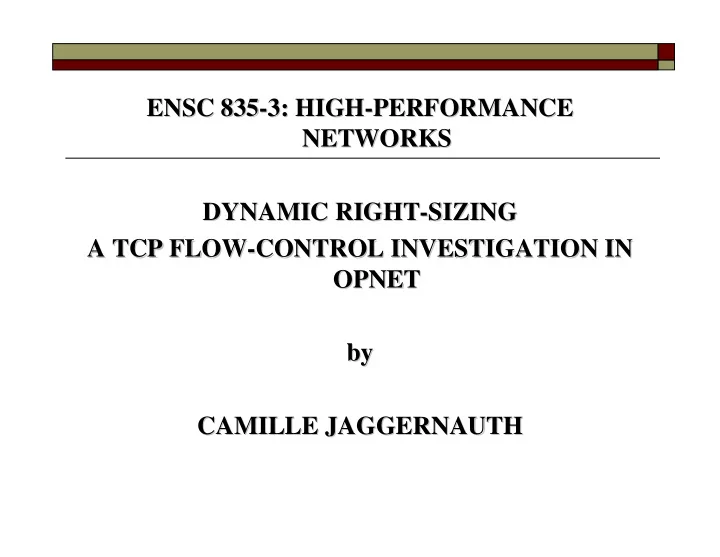

ENSC 835- -3: 3: HIGH HIGH- -PERFORMANCE PERFORMANCE ENSC 835 NETWORKS NETWORKS DYNAMIC RIGHT- -SIZING SIZING DYNAMIC RIGHT A TCP FLOW- -CONTROL INVESTIGATION IN CONTROL INVESTIGATION IN A TCP FLOW OPNET OPNET by by CAMILLE JAGGERNAUTH CAMILLE JAGGERNAUTH
ROADMAP ROADMAP � Introduction � Flow Control in TCP � OPNET Investigation of Dynamic Right Sizing � Results � References
INTRODUCTION INTRODUCTION � Networking researchers typically manually optimizing TCP buffer sizes � To keep the network pipe full � Achieve acceptable performance over the wide-area network.
INTRODUCTION INTRODUCTION � Cumbersome � Sub-par performance for connections with larger delay-bandwidth products � Misappropriation of scarce resources to connections with smaller delay-bandwidth products
INTRODUCTION INTRODUCTION � Originally implemented in ns � Dynamic Right sizing lets the receiver estimate the sender’s congestion window size � Uses this estimate to dynamically change the size of the receiver’s window advertisements. � As a result, the sender will be congestion- window-limited rather than flow-control- window-limited
TCP SEGMENT STRUCTURE TCP SEGMENT STRUCTURE
FLOW CONTROL IN TCP FLOW CONTROL IN TCP � Receive side of TCP connection has a receive buffer � App process may be slow reading from buffer � Won’t overflow receiver’s buffer by transmitting too much, too fast
FLOW CONTROL IN TCP FLOW CONTROL IN TCP � RcvWindow = RcvBuffer-[LastByteRcvd - LastByteRead] � Rcvr advertises spare room by including value of RcvWindow in segments � Sender limits unACKed data to RcvWindow guarantees receive buffer doesn’t overflow
OPNET SETUP OPNET SETUP
OPNET SETUP OPNET SETUP
TCP NODE MODEL TCP NODE MODEL
TCP PROCESS MODEL TCP PROCESS MODEL
TCP MODEL PROCESSES TCP MODEL PROCESSES � tcp_manager_v3.c � Represents the root process of the “tcp” module. � It manages a set of TCP connections by invoking the appropriate api processes
IMPLEMENTATION STRATEGY IMPLEMENTATION STRATEGY � Receiver can determine the sender size by below equation � d is bytes of data received � round trip times between Nmin and Nmax
IMPLEMENTATION STRATEGY IMPLEMENTATION STRATEGY � Observing the Congestion Window variable change � Altering the receiver buffer window accordingly
STATISTICS OBSERVED STATISTICS OBSERVED � Delay � Receiver Window Size � Congestion Window Size � Flight Size (sent but unacked data in sender buffer) � Traffic Received
RESULTS RESULTS � The first 25 transfers used the default window sizes of 64 kilobytes for both the sender and receiver. � The second 25 transfers, shown in dotted lines, used dynamically sized windows
RESULTS RESULTS
RESULTS RESULTS
RESULTS RESULTS
REFERENCES REFERENCES � Mike Fisk and Wu-chun Feng, Dynamic Right-Sizing: TCP Flow-ControlAdaptation, in Proceedings of the 14th Annual ACM/IEEE SC2001 Conference,November 2001. http://public.lanl.gov/radiant/pubs/drs/sc2001-poster.pdf � RFC1323 – TCP Window Scale Option � Kurose and Ross – Chapter 3 presentation slides pg 72, 73 Computer Networking: A Top Down Approach Featuring the Internet, 3rd edition. Jim Kurose, Keith Ross Addison-Wesley, July 2004. � Van Jacobson, Congestion Avoidance and Control, in Proceedings,SIGCOMM 1988 Workshop. ACM SIGCOMM, Aug. 1988, pp. 314-329, ACM Press,Stanford, CA. � Jeff Semke, Jamshid Mahdavi, and Matt Mathis., Automatic TCP buffertuning, Computer Communications Review, vol. 28, no. 4, pp. 315-323, Oct.1998. � Jian Lui and Jim Ferguson,"Automatic TCP socket buffer tuning,"inSupercomputing 2000 Research Gems, Nov. 2000, Awarded Best Research Gem ofthe Conference Brian L. Tierney
Recommend
More recommend